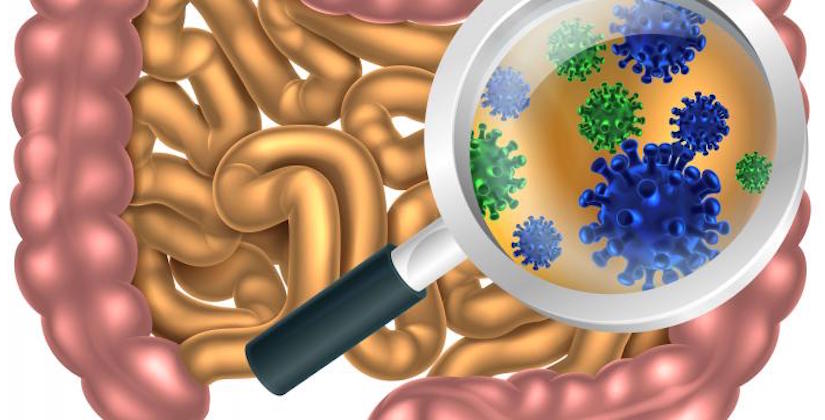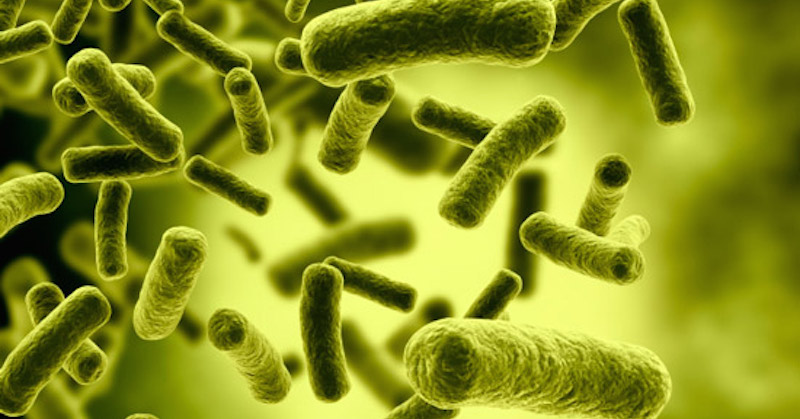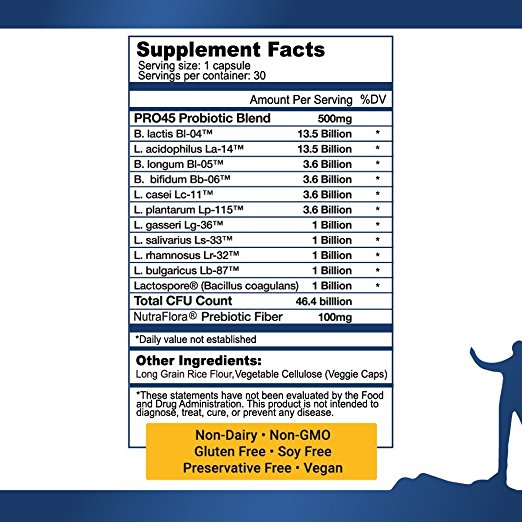How To Choose The BEST Probiotic Supplement For Your Needs
Last updated on
If you have been prescribed or are already taking a probiotic supplement, how do you know that it is the best probiotic supplement for you that specifically meets the requirements for your condition? Read on …
The latest scientific studies affirm that around 0.3% of your body weight is composed of bacteria (contrary to the outdated and inaccurate statements of 1-3%). That’s about 200 g (7 oz) for every 70 kg (154 lb), made of 38 trillion bacterial cells, collectively called the human microbiome!
Quite a lot, isn’t it? But what do we need all of these bacteria for? Do they have a function?
The answer is yes, and no. This multitude of bacteria does not really have a specific “function,” just like human beings don’t have one regarding the planet Earth. We live on it, the bacteria live on us (and in us), and this coexistence can have all sorts of possible outcomes in both cases. Just like mankind can drastically change the planet either for good or bad, the bacteria that inhabit our bodies can either provide us with strong health or become the cause of life-threatening diseases.
Good people make the world a better place, bad people destroy it.
Good bacteria keep you healthy, bad bacteria can kill you in a matter of days.
This brings us to a fundamental question: which bacteria are good for you?
Probiotics are!
Understanding Probiotics: The Basics
Probiotics are live microorganisms that allegedly provide health benefits when consumed. The concept itself was introduced in 1907 by Russian scientist Ilya Mechnikov, who noticed that Bulgarian peasants who regularly consumed yogurt tended to live longer, thanks to such a diet.
This observation gave birth to the idea that by eating certain microbes, humans could modify the microflora in their guts, replacing the harmful bacteria with healthy ones. But there are thousands of different bacteria out there, so how can we define which ones are “healthy” to take?
More than a hundred years have passed, and we still don’t have a definitive answer to this question. Although numerous studies were carried out, and dozens of microorganisms tested for safety and potential health benefits, the data from scientific studies remains somewhat controversial. Small researches report major health benefits, while trials of larger scale indicate that the effects may differ greatly from one person to another.
All in all, these are the few universal principles that any probiotic must follow to be considered potentially beneficial for the customer and suitable for future research:
- Probiotics must be alive at the time of ingestion. This is an absolute principle, otherwise the product or supplement itself can’t be considered a probiotic in the first place.
- Probiotics must have a clearly defined microbe or combination of microbes (up to the species or strain level). For example, if a supplement states it contains beneficial “Lactobacillus” without mentioning any other specific details—it is very likely to be a fraud trying to make money on a well-known term. Lactobacillus is a family of bacteria, and the whole family can’t be a probiotic. Instead, look for specific supplements like those containing Lactobacillus delbrueckii, Lactobacillus acidophilus, or Lactobacillus rhamnosus.
- Probiotics must be safe for use. Before ever considering creating probiotic supplements with a certain strain of bacteria, researchers and manufacturers must perform a series of animal and human studies to verify that this strain would not bring any harm to the customer.
Scientifically Proven Benefits Of Taking Probiotics
Well, now that you know that probiotics are live microorganisms that could be great for your health, let’s get more specific and talk about the different benefits you can expect from taking them.
Below you will find a detailed list of probiotics species and strains that have shown different health benefits in scientific studies from all around the world. The only important thing to remember here is that it’s almost impossible to say with 100% certainty whether probiotics will be helpful in your specific case or not. The reason for this is exceptionally simple: there are just too many variables in this equation.
For example, the species of probiotics of your choice could be not effective at all if it’s incompatible with your guts’ usual microflora, but it also could be exceptionally beneficial for your health. There’s just no way to know without trying. One thing is for sure: probiotics (both natural and in form of supplements) won’t do you any harm. If so, why don’t you try them out and see if they are good for you? 🙂
Now let’s move on to some specific points backed by serious science.
- Probiotics (especially Lactobacillus rhamnosus GG) are effective in treating and preventing acute infectious diarrhea.
- Such probiotics as Saccharomyces boulardii and a combination of Lactobacillus acidophilus and Bifidobacterium bifidum were proven to be quite effective for the prevention of traveler’s diarrhea.
- Boulardii, L. rhamnosus GG, as well as probiotic mixtures of the two species are beneficial for prevention and treatment of antibiotic-associated diarrhea (AAD), a common side effect of antibacterial therapy.
- Boulardii is effective in preventing (but not treating) Clostridium difficile infection (CDI), another common side effect of conventional treatment with antibiotics.
- Certain concentrated combinations of probiotics, such as VSL#3 (Lactobacillus acidophilus, L. casei, L. delbrueckii subsp. Bulgaricus, L. plantarum, Bifidobacterium breve, B. infantis and B. longum, Streptococcus thermophiles) have shown fabulous results in the prevention and treatment of pouchitis, an inflammation of the artificial rectum in patients after colectomy.
- Coli Nissle 1917 and the probiotics mixture VSL#3 could be a fabulous complementary approach for the management of ulcerative colitis.
- Lactobacillus rhamnosus GG, Escherichia coli Nissle 1917, and Saccharomyces boulardii have all shown promising results in certain studies on Crohn’s disease, but more trials are needed to confirm the benefits.
- Strange as it may sound, taking certain probiotics (L. acidophilus, L. paracasei, L. casei, L. rhamnosus, B. longum, L. johnsonii EM1, L. gasseri, Bacillus clausii, E. coli Nissle 1917) can significantly reduce symptoms of hay fever (allergic rhinitis).
- Acidophilus, L. rhamnosus, Streptococcus thermophilus, and L. delbrueckii subsp. bulgaricus could be quite effective for the treatment of vaginal candidiasis (Candida albicans infection) and bacterial vaginosis when applied topically (inside the vagina).
- B. longum, acidophilus and L. plantarum were proven to be beneficial for lowering levels of total cholesterol and LDL-cholesterol, thus possibly reducing risk of cardiovascular conditions.
The listed diseases and conditions are the ones that were most frequently covered in serious scientific trials, thus you can be sure that these species and strains of probiotics really have certain health benefits that, although may vary from one person to another, will be fabulous nevertheless.
Okay, so now that you know, what do you expect from your probiotics supplement? Let’s take a look at the various forms of probiotics products that are available on the modern market, as well as their pros and cons for you.
What Are The Most Common Forms Of Probiotics?
Fermented Products
This is by far the most natural way to take probiotics. It is believed that any kind of fermented product, be it dairy—kefir, cheese, yogurt, sour cream, etc.; or non-dairy—pickles, sauerkraut, kimchi, miso, tempeh—contains a certain amount of beneficial bacteria.
Pros:
- Affordability and availability. These products are usually cheaper than specific supplements, and you always have quite a few options to choose from at your local market or store.
- Ease of integration into the diet. Pick a product you like and start eating it regularly—and that’s all there is to the matter. What could possibly be easier?
- In case of dairy-based fermented products, you can expect a hundredfold enhanced bacterial survival index, meaning that 100x more bacteria will reach your guts alive after contact with stomach acid.
- Effective in the upper parts of the gastrointestinal tract.
Cons:
- It’s hard to tell what species and strains of bacteria you are taking when eating fermented products, thus you can’t be 100% sure of getting any scientifically confirmed health benefits.
- Certain foods of this group may be not suitable for people with dietary restrictions (for example, they may not be an option for vegans or people).
- Subjective taste preferences. Not everyone likes sour milk products, and such people could prefer taking a probiotics supplement.
- Not the best choice for travelling, as these foods often require refrigerated storage conditions to be met if you want to keep the bacteria alive.
Probiotics In Capsules
If you don’t like the taste of fermented foods, capsules with probiotics are the first alternative option to consider.
Pros:
- Probiotics capsules are easy to take.
- You will know exactly what species and strains of microorganisms you’ll be taking, as well as how much of them you’ll have in each capsule. This allows choosing a specific probiotics supplement for the treatment of a specific health condition.
- Suitable for people with dietary preferences and/or restrictions.
- Probiotics capsules do not contain binders (as in tablet form) that would keep the bacteria together in a certain form.
Cons:
- Probiotics capsules cost significantly much more than fermented products or probiotics powders.
- Probiotics capsules do not work in the upper parts of the gastrointestinal tract (esophagus and stomach) unless chewed or opened (which is not recommended).
- Some people may be allergic to the components of the capsule itself, or to some of the capsule’s excipients (for example, potato starch or gluten).
Probiotics In Tablets
This option could be beneficial for people who want their supplement to work in the upper parts of the gastrointestinal tract, for example, to fight a Helicobacter pylori infection, but do not like probiotics in powders for some reason.
Pros:
- Tablets are as easy to take as capsules.
- Unlike capsules, tablets work in the upper parts of the gastrointestinal tract, thus may be suitable for the treatment of conditions localized there, as in cases of SIBO (small intestines bacterial overgrowth).
- Specificity and certainty: you’ll know exactly how much and of what species and strains of microorganisms you’ll be taking with each tablet.
Cons:
- Higher cost.
- May contain binders and excipients not suitable for certain people (for example, starch or gluten)
Probiotics In Powder
Of all available commercial forms of probiotics supplements, powders are, perhaps, the most versatile and preferable from a cost-benefit point of view.
Pros:
- Easy to take. Powders can be added into foods and drinks for the customer’s convenience.
- Effective in the upper parts of the GI tract.
- Dosages are easily adjusted whenever you may need or want.
- Usually do not contain potentially harmful or allergenic binders or excipients.
- Just like with other forms of commercial probiotics supplements, you will know the specific species and strains of bacteria you will be taking.
Cons:
- Virtually none, but not all species and strains of beneficial microorganisms are available in form of powders.
What Is CFU, And How Much Of Them Should You Take?
The amount of bacteria in a single dose (tablet, capsule, etc.) or unit of volume of probiotics is represented by the CFU (colony forming unit) count. In simple terms, every living microorganism equals to one CFU, and most probiotics supplements have from one million to 10 billion (1010) CFU in a single dose.
But is that enough? How many bacteria should you take to expect the desired health benefits?
As a rule, scientific studies recommend a minimum of 106 to 107 CFU per gram of product, as this should be enough to consider a probiotic functional, but it turns out that different species and strains of antibiotics may have different concentrations thresholds to be effective.
For example, Lactobacillus reuteri are effective in minimum concentrations in as little as 107, while Lactobacillus rhamnosus may be needed in a bit larger minimum amounts, 109 specifically.
All in all, just to be sure, it is recommended to take at least 109 CFU of the desired probiotic per day. In any case, be sure to get familiar with the manufacturer’s instructions and the product’s label to learn the recommended dosage for better effect.
Summary: 3 Easy Steps To Choose The Best Probiotic Supplement
Step 1: What Do You Need This Probiotic For?
The first step in picking the best probiotic supplement is to define what do you expect to get from it. Carefully read through the list of scientific studies that we’ve gathered for you above, and check whether your condition or disease is present on the list: this will show you the species (and strain, in some cases) of probiotics that you should look for.
For example:
- If you’re planning a trip abroad and would like to prevent a bad case of traveler’s diarrhea, the best choice of probiotics would be either Saccharomyces boulardii or a combination of Lactobacillus acidophilus and Bifidobacterium bifidum.
- If you are currently taking antibiotics and would like to prevent diarrhea-like side effects, opt for Lactobacillus rhamnosus GG.
- If you suffer from hay fever (allergic rhinitis) regularly, Lactobacillus acidophilus is one of your best friends.
Step 2: Choose The Most Suitable Form Of Probiotic Supplement
After defining your target species and strain, read through our list of forms of probiotic products and check whether your probiotic species is available in the desired form.
If you don’t have a specific disease or health condition that you would like to treat with probiotics, but would still like to take them for a stronger health, your best pick would be natural fermented foods such as kefir, yogurt, sauerkraut, and so on. There are dozens to choose from, and you won’t need to pay extra money for a fancy label!
Step 3: Read The Manufacturer’s Instructions Carefully (And Follow Them)
Each probiotic supplement has a different amount of beneficial bacteria per tablet or capsule, so be sure to check the recommended dose. Follow the provided instructions for the best results.
Alternatively, if you feel like sticking to fermented foods instead of going with commercial products, just eat them regularly in the amounts you feel comfortable to take. For example, a little bowl of sauerkraut each 1-2 days or a glass of kefir every morning should be more than enough.
All in all, there’s one thing we know for sure about probiotics. Although the scientific and medical communities do not have a universal opinion on this matter and warn both manufacturers and customers from relying too much on the possible health benefits of probiotics, thousands of people from all around the world have stated in hundreds of different studies that probiotics really helped them in making their health stronger. So, if there’s even the slightest possibility of that being true, why would anyone skip it?
Pour yourself a cup of homemade kefir, and bon appétit!
Some of the links I post on this site are affiliate links. If you go through them to make a purchase, I will earn a small commission (at no additional cost to you). However, note that I’m recommending these products because of their quality and that I have good experience using them, not because of the commission to be made.
Comments
Leave a Reply





































 JOIN OVER
JOIN OVER
That was a comprehensive article on probiotics.
In your article, Kombucha was not mentioned.
So my question is, does it mean that Kombucha is not part of probiotics?
Thank you.